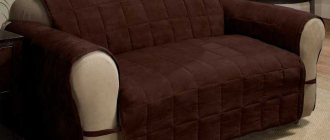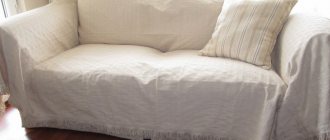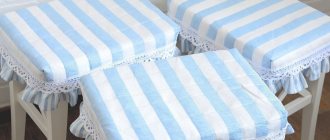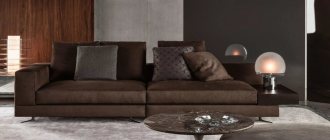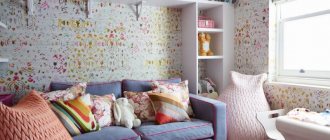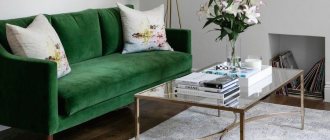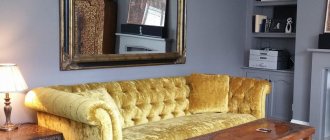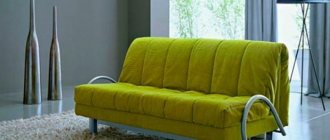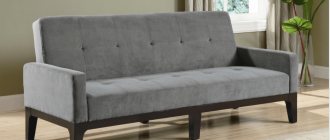When purchasing new upholstered furniture, few people think that after some time it will lose its original appearance. The fabric will wear out, the armrests will begin to shine, and difficult-to-remove stains or holes may appear. It’s easy to protect the upholstery of your favorite furniture or “give a second life” to old ones. All you have to do is sew a sofa cover with your own hands.
During daily use, upholstered furniture wears out the fastest.
Advantages of a self-produced product
- Compared to restoration, this is a cheaper method.
- It is convenient to use and easy to wash.
- Opportunity to create your own unique design.
- The process does not require professional training and takes several hours.
- You can make several models and experiment with the appearance.
- If there are chairs from different sets next to upholstered furniture that are completely out of harmony, additional covers made for them will solve the problem.
- Handmade products are highly valued.
The fabric fades, is wiped out in places, stains, puffs, and others appear on it.
Since the cover will experience a lot of stress at the seams, especially if the pattern is very tight, some seams can be stitched twice.
Master class on sewing a cover
We invite you to familiarize yourself with the tailoring of several options for removable sofa covers for products of various designs and dimensions.
Required tools and materials
To make a sofa cover you will need:
- paper - for creating a pattern;
- tape measure;
- chalk;
- textile;
- scissors;
- threads;
- needles;
- safety pins;
- wooden planks;
- sewing machine.
It is imperative to organize a spacious workplace where it will be convenient to create a drawing, cut out parts and assemble the product. The ideal option is a large folding table.
Cutting out parts
To create a pattern, you need to measure the furniture and transfer the measurements onto paper, observing all the bends and protrusions of the sofa. This matter is quite complicated, so we suggest simplifying the task. Take an old cover, open it up and make a pattern using it. Transfer the outline onto paper or directly onto fabric. If there is a flounce on the cover, then this detail can be drawn later. The finished pattern should be cut out, attached to the wrong side of the fabric and outlined with chalk. Be sure to leave seam allowances of at least 1 cm wide.
Sewing a cover for a sofa book
The process of making a cover for a sofa book is as follows:
- we make a pattern;
- transfer the drawing to the fabric - it is advisable to choose an elastic material;
- cut out the parts along the contour;
- we outline the area where the elastic will be located;
- we connect the pieces of fabric together - since the cover is a combination of several elements, the parts for the back, armrests and seat are assembled separately;
- We sew all the seams on the machine.
After completing all the steps, the protective covering for the click-klyak sofa or Eurobook will be completely finished.
Sewing a cover for a corner sofa
Making a cover for a corner sofa has its own characteristics. Necessary:
- attach the material to the sofa using safety pins;
- use pins to mark the sides, seat, back, armrests;
- sweep all the lines, trying to follow the curves of the furniture. You can use chalk;
- trim off excess fabric, remembering to leave seam allowances;
- connect the cut parts in pairs. We sew the back and seat elements separately;
- Unscrew the covers and try them on the furniture. If adjustments are necessary, mark problem areas where the seam needs to be narrowed or widened;
- we correct defects and sew seams using a machine.
Sewing a cover for a sofa with armrests
Step-by-step instruction
- We take measurements from the furniture. It is necessary to determine the main parameters - the length and width of the sofa, and also measure the armrests. The width of this element is the distance from the floor to the top.
- We build a pattern based on the measurements obtained.
- We transfer the outline of the parts to the fabric, retreating 1 cm to create allowances.
- We assemble the covers into separate parts - back, seat, armrests;
- We connect the parts together manually and secure them with a machine seam.
Sofa cover with elastic band
The elasticated cover is incredibly comfortable. It is ideal for a regular three-seater sofa or an accordion-type device. The second name for this option is Eurocase. It stretches perfectly, tightly hugging the sofa, is well fixed on the product, and does not move out. In order to make it, you should:
- take accurate measurements of the length and width of the sofa;
- add an additional 5-7 cm to the dimensions for attaching the elastic;
- cut out the future product taking into account allowances;
- sew on the elastic using a sewing machine, folding the fabric along the edges;
- try it on to identify a loose fit.
- correct shortcomings;
- stitch the seams.
The size of the cover must match the dimensions of the furniture and fit snugly to the surface of the sofa.
Design and construction
Before you start sewing, you need to decide what the future product should look like. To do this, you need to analyze the type of sofa you have. It can be two- or three-seater, with soft or wooden sides or no armrests at all. The most difficult thing is to sew a cover for a corner sofa with your own hands.
The fabric fades, is wiped out in places, stains, puffs and other marks that are not pleasing to the eye appear on it.
You need to carefully measure all the areas and details, draw them in a reduced form on paper, and then make a layout taking into account the direction of the pattern or fabric design, the grain line.
Moreover, it should consist of several rectangular elements and completely cover the surface of the upholstery. You can secure it with an elastic band. The sagging will be eliminated by cords or braid attached to the drawstring and tied to the legs. Additional elements such as frills and ribbons will add elegance.
Ordinary blankets or capes solve the problem only partially - they get confused, move out, and besides, they cover (protect) only the front part of the sofa.
There are many patterns on the Internet for creating models that resemble those offered in stores. So, if you decide to make covers for your sofa and armchairs with your own hands, you will find a diagram. For the set, you can add a universal chair cover with an elastic band, sewn by yourself.
Covers for sofas, chairs, and armchairs are a proven way to update upholstered furniture with a minimum of financial costs and effort.
Look at the photo how easily you can turn any furniture into a work of art using furniture covers.
Necessary materials:
- sewing machine with overcasting capability;
- tailor's tape or tape measure;
- ruler;
- pins;
- scissors;
- a piece of chalk or soap for marking;
- matching threads;
- and a little patience.
Renewing furniture - even with the most careful and careful treatment of furniture, over time it begins to shine, the fabric loses its color saturation, and wears out.
The most important thing you need to sew sofa covers with your own hands is fabric. The material for the bedspread must be durable, wear-resistant, and easy to clean. For these purposes it is recommended to use:
- jacquard;
- flock;
- Shinil with a plush surface;
- pleated;
- microfiber;
- leatherette;
- eco leather;
- natural or artificial fur.
The issue of updating and completely restoring the appearance can be fundamentally solved by reupholstery, which is associated with certain problems and risks.
Removable covers for upholstered furniture not only keep the upholstery of the furniture in its pure form, but also have a number of other useful advantages.
To make a Euro sofa cover with your own hands, you will have to purchase more elastic fabric.
Covers allow you to update only the outer, outer surface, without interfering with the inside of the sofa, which means that the factory assembly of the sofa (chair) is preserved, which will increase the service life.
Covers for sofas, covers for chairs or armchairs have become very fashionable again these days.
Sizing and material selection
One of the important points is determining the size of the bedspread. In order for the measurements to be accurate, you should measure the sofa itself and, for reliability, write down the resulting numbers on paper. Patterns will be made from them in the future.
Stages of repairing a sofa with your own hands, taking into account the specifics of the malfunction
Step by step steps:
- Measure the dimensions of the furniture - length, height, width.
- Transfer the obtained data in a reduced version onto paper.
- Add 5 cm to the sides (for seams and allowances).
If the bedspread has lace or ruffles, the height is reduced by 2–3 cm.
As for the material, there is a wide choice. Each option will be special in its own way. You can take synthetics or natural fibers, fur. When choosing a particular textile for a bedspread, it is worth remembering that it should:
- match the design;
- do not fade, do not fade;
- be practical;
- do not shrink after washing;
- easy to clean.
In addition to other characteristics, a hand-made blanket for a sofa should be beautiful and please the hostess. If preference was given to fur or wool, then the coming frosts in winter will not be terrible. Many people choose knitted blankets for the sofa. They can be beautifully decorated with multi-colored threads and unusual patterned knitting. Quilted blankets will protect you from the cold and help create a warm environment.
It would be advisable to pre-wash synthetic fabric. If it is noticed that it has shrunk significantly, then it is better not to sew a bedspread from it. Such material is unsuitable for this purpose, because after several washes it will shrink even more.
A silk or satin bedspread is suitable for lovers of sophistication. It will be difficult to work with such materials if the craftswoman does not have the skills. It is better for such needlewomen to give preference to cotton fabrics.
JacquardIt is better not to choose bedspreads with thick pile for those who have pets - their fur will be difficult to clean.
Fur
Cotton
Silk
Wool
Main stages of sewing
The first step is to measure the armrests, ottomans, seat and backrest. Then create a pattern and calculate the amount of material needed. Each piece must have seam allowances of at least 7 cm.
- All details are transferred to paper and cut out. The fabric should be laid out on a hard surface. The diagrams are superimposed on the material and outlined around the edge with a piece of chalk or soap.
- The cut parts are sewn down with a stitch, after which it is better to try on the product and secure it with pins. If it is small or loose, then you need to adjust the pattern or change the size of the allowances.
- After adjusting to the dimensions of the furniture, you need to remove excess parts of the fabric, leaving only 3 cm for allowances. Then you should overcast and sew the edges. It is better to wash the resulting blanket in cool water and iron it.
- To create covers for sofas and armchairs with elastic with your own hands, you will have to perform several additional operations with the bottom edge. To do this, you need to turn it inside out and draw a straight line with a pencil along which the elastic will go. Then, you need to secure it parallel to the edge of the marking, securing it every 5-10 cm with pins or thread. To sew in elastic, you will need a sewing machine that allows you to create a three-step (elastic) seam.
At the same time, the cover does not require special installation - you just need to put it on the sofa and fasten the Velcro, buttons or zipper.
You will get a wonderful cover for furniture - quickly and easily.
Case shape and design
Before you start making a case, you need to think about its shape and decide on the size. There are various models. The cape can completely cover the elements of the sofa along with the legs and create the illusion of a complete floating object. Such products are suitable for classic, romantic, modern, English interiors.
Connoisseurs of modern styles will appreciate covers that ideally match the dimensions of the furniture or models presented in the form of separate covers for the seat and armrests. In this case, there is a taboo on any decorations - frills, bows, flounces. A good find for decorating such options is simple organizers in the form of pockets placed on the outside of the armrest. This is a great bonus for reading and app lovers. You can put a magazine, a regular or e-book, a tablet, headphones, a diary and many other small things you need in your pocket. Such models fit perfectly into high-tech and country, minimalism or eco-style.
The size and model of the cover affects the choice of fabric colors. If the canvas completely covers the furniture, then you should focus only on the general color palette of a particular interior. If it is only a small cape, it should be in harmony with the upholstery.
How to knit a cover with your own hands. Step-by-step instruction
To knit a universal sofa cover with your own hands, you will have to spend a lot of time and effort. The product can be several interconnected canvases, knitted with knitting needles or a set of square crocheted motifs.
Furniture protection - covers will be a real salvation if there are small children or pets in the house.
A cover for a sofa is really convenient both in practical terms and in terms of changing the surroundings.
To create a knitted cover, you will need to purchase thick threads, as well as working tools. It is better to choose the pattern and color scheme in accordance with the interior. You can use different types of thread. Just as in the previous case, you will have to take measurements of the furniture and prepare a pattern, which must be followed in the process of knitting the fabric.
They, without limiting the use of furniture by all family members, will help preserve the original appearance of the furniture.
It will retain the natural color of the upholstery for a long time and will not be damaged by the claws of pets.
If “motifs” are used for manufacturing, it is recommended to measure the area of the pattern and one square. Based on the obtained dimensions, calculate the number of required squares and skeins of thread.
They will become a kind of barrier, preventing the appearance of puffs and scratches; animal hair does not stick or roll off in the upholstery.
Your furniture will be reliably protected from dust and grime.
If the product is created from knitted fabrics, it is better to calculate the surface area in advance. Once in a sewing store, pay attention to the thread label. As a rule, it indicates two numbers corresponding to the knitting density. Knowing them, it is not difficult to calculate (on your own or by contacting an employee) the required number of skeins.
The fabric has a pronounced stretch effect, restoring its shape after pressure.
Many small fibers are applied to a dense fabric base with the help of glue, from which a velvety surface is obtained.
Manufacturing materials and tools
A sofa cover can be made from different fabrics. The choice depends on individual preferences. The easiest way to care for fleece and tapestry. They practically do not fade in the sun, they can be washed in an automatic machine.
| Velours | Looks impressive, but attracts dust and static electricity |
| Flock | Externally similar to velor, but costs less and has a shorter service life |
| Microfiber | The fabric is easy to care for, but easily absorbs and retains foreign odors for a long time. |
| Cotton | Natural fabric, does not cause allergic reactions, can be used for covers on children's furniture. Disadvantages: fades when washed and fades in the sun |
| Jacquard | Durable fabric that lasts a long time, maintaining color and structure. But the material can become very wrinkled and stretched during automatic spinning during machine washing. |
The fastest and most effective ways to clean a sofa at home
The main requirements for the material for sewing a cover are practicality and hypoallergenicity (especially if you need to sew a blanket for children). Ease of care and cleaning is also very important. Color fastness matters. And, of course, it’s good when the fabrics are pleasant to the touch, this creates additional comfort.
You should purchase fabric in a store so that you have enough to spare when sewing. If there is still material left after cutting, you can use it to sew decorative sofa pillows to match the cover.
Velours
Jacquard
Microfiber
Flock
Cotton
Decoration
You can decorate the finished product with bows, appliques or stripes. To decorate the armrests, a decorative rope with a diameter of 1 cm is best suited. Framing with a wide braid or ribbon will help to emphasize the lower part.
Covers for a sofa (chairs) can radically change the visual perception of furniture.
The isoprene layer plus dense pile allows you to avoid puffs.
Decoration options
It is not difficult to sew covers for a sofa; in addition, they can be decorated in an original way. The decor depends on the style in which the product was originally conceived, as well as on the material of manufacture. A properly designed bedspread should fit organically into the surrounding environment and not look like an alien element. Most often, modern needlewomen use for decoration:
- laces;
- ribbons;
- bows;
- decorative rope;
- embroidery;
- applique.
The simplest design option is a wide braid along the edge. It can be a contrasting color compared to the blanket or, conversely, a similar shade. Silk bedspreads are most often decorated with embroidery. Popular designs for sofa covers are floral and geometric patterns, as well as (for experienced craftswomen) designs in Oriental, Japanese or Chinese styles.
Recommendations for sewing a bedspread for a sofa with your own hands, types of decor
If there are animals at home, you should not decorate the cover for the corner sofa with pom-poms or tassels. Such decoration will definitely attract the attention of pets and will soon lose its original appearance. Bedspreads for a baby crib are usually not decorated with sequins, beads and beads; If these small elements are not sewn carefully, the child can easily tear them off and swallow them.
The main requirement for decor is a reasonable combination of beauty and practicality. If a needlewoman plans to frequently wash the bedspread in a machine, the most suitable option would be an applique or braid along the edge. Embroidery made from satin ribbons is very popular. This is the easiest way to decorate.
To make the applique you will need unnecessary scraps of fabric. First you should think about the composition and draw a simple sketch on paper. Next, you need to cut out the necessary shapes and lay them out on the case to see how the finished decoration will look.
Experienced needlewomen usually sew decorative details with a hidden seam, which is almost invisible from the front side. A novice craftswoman can fix the appliqué details on the material using a special textile glue that does not collapse when the product is washed. This decoration will look beautiful if the room is decorated in Provence (country) style. The most popular motif for applique is an abstract geometric pattern (for example, alternating circles, rectangles, ovals of different colors and sizes).
Products for a baby crib (for girls) can be decorated independently with bows or flowers made from satin ribbons. They are sewn along the perimeter of the product or randomly, at different points of the bedspread. The material for work should be scorched over a fire using a lighter so that the ends do not fray.
A bedspread that a needlewoman has made herself will give the home a unique coziness and help create a warm atmosphere in the room. DIY sofa covers will suit interiors decorated in a variety of styles, from country to classic, and will last a long time if made from high-quality material.
The subtleties of making a cover for a corner sofa
How to sew a cover for a corner sofa with your own hands? In general, you need to perform all the same steps as when sewing a standard model. The difference will be that you will need to cut out a few more rectangular parts.
The procedure for sewing a cover for a complex-shaped sofa can be compared to the ability to make various pillow letters. The corresponding photos show what the layout should be in order to pack all the right angles.
Note!
How to make flowers from cold porcelain: chic floristry and DIY crafts for the New Year step by step
How to make cold porcelain from potato, corn starch, liquid, without soda. Recipes and cooking methods
How to properly make a birdhouse with your own hands from scrap materials: we create an original birdhouse according to sketches
To process the seams from the inside, you should use non-woven tape - this way you will achieve ideal geometry. And for a tighter fit of the canvas, it is appropriate to provide a zipper fastening.
